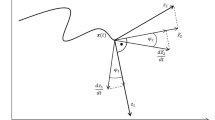Abstract
Some classes of dissipative and Hamiltonian distributed systems are described. The dynamics of these systems is effectively reduced to finite-dimensional dynamics which can be “unboundedly complex” in a sense. Yarying the parameters of these systems, we can obtain an arbitrary (to within the orbital topological equivalence) structurally stable attractor in the dissipative case and an arbitrary polynomial weakly integrable Hamiltonian in the conservative case. As examples, we consider Hopfield neural networks and some reaction–diffusion systems in the dissipative case and a nonlinear string in the Hamiltonian case.
Similar content being viewed by others
REFERENCES
S. A. Vakulenko, Ann. Inst. H. Poincaré, 66, 373 (1997).
S. A. Vakulenko, Adv. Diff. Equat., 5, 1739 (2000).
G. Nicolis and I. Prigogine, Self-Organization in Nonequilibrium Systems: From Dissipative Structures to Order Through Fluctuations, Wiley, New York (1977).
H. Haken, Synergetics: An Introduction (3rd ed.), Springer, Berlin (1983).
Y. Kuramoto, Chemical Oscillations, Waves, and Turbulence, Springer, Berlin (1984).
O. A. Ladyzhenskaya, Russ. Math. Surv., 42, 27 (1987).
J. K. Hale, Asymptotic Behavior of Dissipative Systems, Am. Math. Soc., Providence, R.I. (1988).
A. B. Babin and M. I. Vishik, J. Math. Pures Appl., 62, 441 (1983).
P. Constantin, C. Foias, B. Nicolaenko, and R. Temam, Integrable Manifolds and Inertial Manifolds for Dissipative Differential Equations, Springer, New York (1989).
Yu. Il'yashenko and Weigu Li, Nonlocal Bifurcations [in Russian], Moscow Center for Continuous Mathematical Education (MCCME), Moscow (1999); English transl., Am. Math. Soc., Providence, R.I. (1999).
P. Poláčik, J. Diff. Equat., 119, 24 (1995).
E. N. Dancer and P. Poláčik, Mem. Am. Math. Soc., 140, No. 668, 1 (1999).
J. J. Hopfield, Proc. Natl. Acad. Sci., 79, 2554 (1982).
R. Edwards, Math. Meth. Appl. Sci., 19, 651 (1996).
G. M. Zaslavskii, R. Z. Sagdeev, D. A. Usikov, and A. A. Chernikov, Sov. Phys. Usp., 31, 887 (1989).
N. V. Nikolenko, Russ. Math. Surv., 35, 139 (1980).
J. Bourgain, “Nonlinear Schrödinger equations,” in: Hyperbolic Equations and Frequency Interactions (IAS/ PARC City Math. Ser., Vol. 5, L. Caffarelli et al., eds.), Am. Math. Soc., Providence, R.I. (1999), p. 3.
A. K. Abramyan, J. Tech. Acoustic, 2, No. 3, 5 (1995).
Author information
Authors and Affiliations
Rights and permissions
About this article
Cite this article
Abramyan, A.K., Vakulenko, S.A. Dissipative and Hamiltonian Systems with Chaotic Behavior: An Analytic Approach. Theoretical and Mathematical Physics 130, 245–255 (2002). https://doi.org/10.1023/A:1014243500528
Issue Date:
DOI: https://doi.org/10.1023/A:1014243500528




